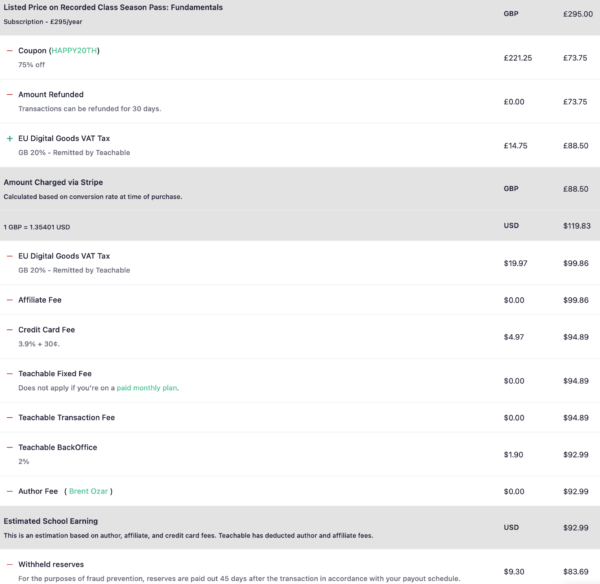BrentOzar.com is 20 years old, so I’m spending 20 days reflecting. Yesterday, I wrote about how my online classes are available to Europeans now, and today I’m going to talk about why that was a problem for a while, and how I solved it.
The short story is that I outsourced the whole thing to Teachable.
For the long story, buckle up: there’s over 2,500 words of navel-gazing in here.
Twenty years ago, BrentOzar.com ran on my own code.

Back in 2001 when I started writing it, BrentOzar.com served two purposes: it helped me share stuff I’d written, and it helped me become a better developer. I liked coding, and I wanted to do it in my spare time, too, and since I wasn’t satisfied with the blog platforms circa 2001, I wrote my own.
When you’re facing a choice of build vs buy, like build your own blogging platform or use an existing one, there are a lot of variables involved:
- The quality of the buy-able options out there (including the free ones)
- Their cost (which is sometimes licensing, but also the hardware it runs on, and the maintenance costs)
- The quality of a solution you could build yourself
- That self-built solution’s cost (because your time is worth money, even if that number is small)
In 2001, when I made the build-vs-buy decision, the available blogging platforms just weren’t that good – the market was too immature – and my personal time cost was really cheap. I wasn’t making a ton of money at my day job as a developer & database guy, so I figured sharpening my development skills would raise my day job skills anyway.
After a few years, that got old,
and I switched to blogging software.
In 2003, I switched to Movable Type, and then in 2006, I switched to WordPress. Blogging had taken off, and the blogging platform market had grown. The quality of what I could get off-the-shelf was way better, so I revisited the build-vs-buy decision.
I decided that if I was going to spend a Saturday sitting in front of a computer, I could either spend that time tinkering with my own blogging platform – OR, I could spend that same time writing blog posts, sharing my knowledge. I decided that the latter was a better use of my time.
Developers make the build-vs-buy decision constantly today, way more than they ever did before, because it presents itself not just with each software platform decision, but every logic decision you wanna make. Wanna, say, process XML? You have tons of decisions to make about which library to use or an online service or write code yourself, and the choices can come back to haunt you if a service or library becomes abandoned, or it reinvents itself in a new version that requires tons of code changes. Developers are practically business owners making long term decisions that affect the cost of a project with every framework decision they make. Get the best ones you can. (Yay, Richie!)
When we started selling online training,
we had the build vs buy decision again.
At the time we made the decision, we thought the online training sales market was mature. There were a lot of learning management systems (LMS’s) out there, with a wide variety of price ranges and features. We hired an LMS consultant to help us navigate the choices, and we settled on a pretty expensive one.

It was a horrible mistake.
The software was garbage. It charged some students, yet told them their credit card was denied. It double-charged some students. It let some students in without even charging them at all. We worked with their support teams over and over, and nothing got better. (Years later, I found out that particular vendor was a bit of a hollow showpiece: they had one really big paying client, and they focused all of their development & support on that one client. Everyone else was an afterthought.)
As the angry customer emails kept piling up, we were forced to revisit the decision.
We moved the training sales in-house,
using WordPress and WooCommerce.
We certainly couldn’t afford to build an e-commerce system from scratch, but there was a bit of a hybrid:
- WordPress for the content and users
- WooCommerce for the e-commerce
- A variety of WordPress plugins to enable training classes
- Some custom code to glue it all together – some Zapier, some custom WordPress code
This worked really well for years – until 2017, when the EU’s General Data Protection Regulation (GDPR) approached. Back in 2017, it just wasn’t clear how the GDPR would be enforced, but the penalties were terribad: up to €20M or 4% of your company’s annual worldwide revenue, whichever is higher. As a small business owner, I looked at those numbers and went, “Nnnnnope.” Only 5% of my sales revenue came from the EU. Just to continue selling to the EU, I would have to invest much more than that 5% of my revenue – and it simply wasn’t worth the investment at that time.
I knew I wanted to be fully GDPR-compliant someday – I do love the ideas behind the law – so I took the steps that made sense for me, like requiring folks to opt in before emailing them, implementing a privacy policy, and processing GDPR portability & erasure requests.
However, I didn’t see a way for the combination of WordPress and WooCommerce to be fully GDPR-compliant. For example, customer data isn’t encrypted – so if someone gets your WordPress database backups, you’re screwed. Even worse, in the WordPress plugin world, it’s very common for plugin developers to say, “For me to debug the problem you’re having with my code, I need full access to your production servers, or else I need a copy of your database.” I just couldn’t do that and still feel confident about GDPR compliance, not without doing a whole lot more legal prep work with each and every plugin developer.
I also didn’t want to dedicate Richie (my developer) to working on it. BrentOzar.com is PHP & MySQL, and that’s not what I hired him to do. He uses serverless technologies to enable PasteThePlan, SQL ConstantCare®, and another project we’re working on, and he already deals with enough context switching. I’ve got enough work to keep him busy for years, and I just wouldn’t want him working on the joyless tasks involving GDPR compliance. I’d have to hire another developer, and the ROI just wasn’t there.
So rather than change our sales platform, I stopped selling to the EU and EEA. That raised a lot of eyebrows at the time, but I still think it was the right thing to do as a small business owner. I heard a lot of database folks say, “Just become compliant – how hard can it be?” I had to laugh, especially when those same folks had wildly non-compliant WordPress blogs, hahaha.
COVID-19 changed the training landscape.

In March 2020, I was leaving Iceland based on the US State Department’s recommendations for US citizens to get home as quickly as possible before borders locked down completely. I knew the conference & training game was about to change dramatically: everybody was going to be learning at home for the foreseeable future.
To deal with the new reality, I raised my online training game: I switched from GoToWebinar (which did a terrible job of GDPR compliance) to streaming with OBS, invested in cameras & hardware, and set up scenes to make training way more interactive. Those changes were successful, and helped the classes sell really well to the American audience. That was my single biggest goal for 2020: taking care of the home crowd. In March 2020, when I was making those decisions, I had no idea how long the quarantines would last, or when vaccines would be available. I figured I’d just take it one year at a time.
The SQL Server business wasn’t the only one impacted by the quarantines, obviously: everyone has to get their training remotely now. 2020 was the year when we saw massive improvements in all kinds of software and SaaS platforms targeted at remote meetings and training.
So this year was a really good time to revisit the build-vs-buy decision. I wanted a training sales platform with:
- The ability to host both recorded and live classes
- GDPR compliance
- EU & UK VAT payment & filing – because I didn’t want to hassle with the complexities of international tax filing in order to gain just 5% more revenue
- Powerful & flexible pricing: subscriptions, one-time pricing, and coupons
And I decided that I would be flexible on any other features – just because I’d gotten used to something in my current WordPress/WooCommerce setup, didn’t mean it would be a requirement in the new training class sales platform.
After a lot of research and testing, I settled on Teachable.com. I migrated my training classes over there, and I’m going to process all class sales through there from here on out. Customers who have existing subscriptions in my WooCommerce/WordPress store can still continue to access their material exactly the same way, and their renewals will continue to work. New customers will just be signing up on Teachable.
Teachable handles a lot for me.
 International sales are a giant pain in the rear because the EU and UK charge value-added-tax on online sales these days. If you sell any goods, even virtual ones, the governments want their piece – even if you don’t have a business presence in the EU or UK.
International sales are a giant pain in the rear because the EU and UK charge value-added-tax on online sales these days. If you sell any goods, even virtual ones, the governments want their piece – even if you don’t have a business presence in the EU or UK.
In the past, this meant registering with every single government where someone bought something online, or registering for a VAT Mini One Stop Shop (MOSS) where you filed all your EU taxes, plus there’s probably something separate now for the UK due to Brexit, and frankly, in the words of a wise philosopher, ain’t nobody got time for that.
Even worse, even when we went through all that several years ago, we still constantly fielded tax questions from people. “I’m trying to buy from South Africa using a French credit card over a Swiss VPN, and I believe I’m tax exempt because I wear white shirts on Thursdays.” I’m sure those questions are still going to come in, but…now I can just point them over to Teachable support and call it a day.
Teachable figures out where you’re buying from, handles the VAT number exemptions, collects the taxes, and even files the taxes and pays them for you. They just pay you out daily, weekly, or monthly (your choice) – and then you deal with your own corporate or income taxes based on your overall royalties. You still get all the control in terms of your course pricing, coupons, and availability, but Teachable just handles the accounting part. It’s doable for them at their scale – whereas for me as a small business, it totally wasn’t doable in a profitable way.
They charge for it, of course.
When I used WooCommerce & WordPress, we had to pay a fixed price for our plugins and hosting charges, and a credit card processing fee to Stripe for each purchase. (When we sold to the EU/EEA, we also paid variable overhead to accounting folks based on how much taxes we were filing.)
Teachable has monthly pricing, plus fees per transaction. I took a screenshot of a Recorded Class Season Pass sale to illustrate how things get a little complex, but before the screenshot, here’s the simple math:
- Course price: $99.86
- I got paid: $92.99 (about 93%)
- Teachable got: $2.00 (2%)
- Stripe got: $4.87 (5% – it looks higher on here, but that’s because they also got a cut of the tax)
The details, which also include currency conversion and taxes and coupons, oh my:
In the past, I’ve repeatedly said that the EU was about 5% of my revenue, so the question becomes: is it worth paying 7% of everyone’s revenue in order to get 5% additional revenue? Obviously not – but that’s not a fair question. We’ve always paid Stripe’s credit card processing fees, so that 5% is a wash. It’s really just a question of, “Is it worth paying 2% more on everyone’s revenue in order to get an additional 5% of revenue?” But that’s not really fair either: the situation is more complex because I can’t use Jilt for revenue recovery, for example, so revenue might go down, too. It’s hard to make these judgement calls in the fog of war. I don’t think I can boil it down to a simple equation, and the numbers are too close to call.
But if they’re too close to call, then I need to do it, because I want to get my training into the hands of more people.
Like any build-vs-buy decision,
there were compromises.
Some of the compromises were related to the GDPR, and others were related to Teachable’s product.
For example, when someone abandoned their shopping cart, I used Jilt.com to send them a reminder, and then a coupon to entice them to finish the checkout process. Jilt worked amazingly well, paying for itself many times over. However, this just isn’t an option with Teachable.
Similarly, when folks bought a BrentOzar.com training class, I automatically added them to Mailchimp, the service I use for email newsletters. I didn’t actually subscribe them to any newsletters – I just wanted them in the database so that when I sent out an update about their training class, I could email them through Mailchimp. Teachable has the ability to do that – but I just decided not to because for the GDPR, I want to minimize the number of places where customer data is kept.
 Another compromise is that Teachable doesn’t really specialize in live training classes. You can embed live streams in the course content, but it’s not like Teachable has event calendars and the ability to buy different specific dates. I wouldn’t have a problem selling seats in individual classes on individual dates, but it would have been painful enough in Teachable that I just skipped it. Plus, the vast, vast majority of my live class attendees just buy a Live Class Season Pass anyway. The folks looking to save money or pick and choose specific classes usually ended up buying the recorded versions, which were cheaper – and they can still do that. I didn’t change the pricing on those. If Teachable ups their game and offers easier individual live ticket sales, I’d embrace that – but for now I’m keeping it simple.
Another compromise is that Teachable doesn’t really specialize in live training classes. You can embed live streams in the course content, but it’s not like Teachable has event calendars and the ability to buy different specific dates. I wouldn’t have a problem selling seats in individual classes on individual dates, but it would have been painful enough in Teachable that I just skipped it. Plus, the vast, vast majority of my live class attendees just buy a Live Class Season Pass anyway. The folks looking to save money or pick and choose specific classes usually ended up buying the recorded versions, which were cheaper – and they can still do that. I didn’t change the pricing on those. If Teachable ups their game and offers easier individual live ticket sales, I’d embrace that – but for now I’m keeping it simple.
I’m fine with compromises like that. If I wanted the perfect online training sales platform for me, then I’d have to hire a team of developers – and the cost on it would be stratospheric, and I’d end up spending too much of my time managing the developers and the platform – and not enough time delivering value to attendees.
I liked the WooCommerce/WordPress combination more than I like Teachable, but Teachable enables me to get the classes in the hands of more students, with less time taken on my part. COVID19 changed the equation there: I just don’t see in-person conferences happening anytime soon, and the customer population in the UK, EU, and EEA continues to grow. I had to be able to service those customers.
Those customers being, uh, you, dear reader.
The work was worth it.
After spending weeks researching tools, picking one, migrating my content over to it, building a bunch of marketing, and going live, the numbers are starting to come in.

Before we stopped selling to the EU, the EU/EEA represented about 5% of our training revenue. In last year’s Black Friday sale, we sold $1M USD. 5% of that would have been another $50K. So leading up to selling to the EU/UK, I defined success as $50K of revenue in the March 2021 launch sale.
48 hours into the sale, I’m happy with the numbers. It’s a success, and the work paid off.
Wanna join in? During March you can use coupon code Happy20th to save 75% off my Live Class Season Pass, Recorded Class Season Pass Fundamentals, or Masters recordings, or any of my online classes.
You can buy in Euros, GBP, or US dollars, whichever currency is more convenient for you. When you click the Buy button, you get your choice of currency, and it calculates your VAT and helps you with exemptions as well.
I’m also offering live online classes in Europe-friendly times: 8:00-16:00 UTC. (UTC keeps it simple since I’m living in Iceland at the moment.)
See you in class!



17 Comments. Leave new
I’ve been a Teachable client for two and a half years because of GDPR and VAT. They do a lot of things well, but they also struggle in a lot of areas as well. They don’t generate invoices, just receipts (and no modifications), their payment system often rejects working credit cards for unknown reasons, if a student is in a subscription they cannot change their credit card, sometimes students don’t get access to what they paid for, up sells aren’t really a thing, and there is no concept of a shopping cart. I could go on, but after working around their systems for years, we are actually looking at moving on with a different vendor. I’d be happy to discuss further if you want.
Oh no, sorry to hear that!
I’m okay with most of those challenges – for example, on the invoices part, you can edit the email confirmation to have it say invoice instead of receipt. I can live without the shopping cart and the upsells.
About the credit card denials – I’m using Stripe for payments, and my experience with the cards so far has lined up with my previous experience with Stripe. When folks get denied, it’s been because they had the billing address wrong most of the time, or they had one of those credit cards that requires them to be redirected to their bank’s page – those never really worked well online.
If there are other platforms you want to discuss, you can shoot me an email at help@brentozar.com. I’ve tried a few and been burned pretty badly along the way too.
Is the Euro pricing amounts as the first display just part of the deal with the new platform or am I just missing a preference somewhere? I think the new site looks really nice, and for whatever reason the Euro amounts are my only turn off. Wouldn’t prevent me from buying, but you asked for honest feedback. Glad you are doing well Brent.
Santee – good news! When you click on Buy, you can choose the currency you want. Cheers!
Thanks for the interesting post Brent. I ended up choosing Thinkific & it’s not a perfect platform either for live sessions but it’s working fine. Right now all of my paid sessions are live, so the fact that Thinkific doesn’t automatically handle VAT for me like Teachable does isn’t a problem (since the EU VAT guidelines say that live courses & webinars are exempt from the digital tax). However, once I get into a fully on-demand offering later this year, with no live interaction component, then I’ve got to deal with it. Thinkific’s recommendation is to use Quaderno integrated with Stripe & PayPal, so that’s a possibility & it’ll work the same as you describe re: every student’s price being effected. I chose Thinkific over Teachable for one feature (cohort groups) & it hasn’t turned out to be quite as powerful as I had hoped. It’s possible that I’ll choose to migrate over to Teachable — so I’ll be keen to hear more about your Teachable experience.
Check out using FastSpring for processing payments with Thinkific. They handle VAT like Teachable. Let me know if you want to discuss further.
Thanks Tim. I will check that out.
Really interesting post Brent! Hopefully I’ll be able to signup to some of your courses now they’re available in the UK. Just trying to work around my companies “preferred training provider” policy…
Because of the nature of teachable.com you can now create 1h class like “Watch Brent Ozar migrate SQL Server database to Azure (2021)” and then crete the same 1h class for 2022, 2023, 2024 and even 2085 when we will be there.
A recorded version of Live hands-on. I would pay for that.
Francesco – sorry, I think I misunderstood your comment. For Azure migrations, check this out:
https://www.brentozar.com/archive/2019/09/free-azure-and-sql-server-2019-training-from-microsoft/
Ah, …well… I knew that post.
I was hoping teachable.com could give you more flexibility. I’ts OK, Brent, I know it’s definetly hard to organize.
It’s not really about flexibility or organization – it’s just not profitable, like I wrote in that post. If I’m going to lose money on something, it’s not going to be that, heh.
MS have got some pretty decent How-Tos for migration to SQL Database or Managed Instance:
https://docs.microsoft.com/en-us/azure/dms
Azure Data Migration Assistant is good.
Excellent 61-part course on Azure SQL – it’s as good as a couple of courses I paid for (doh!):
https://youtu.be/Dtr6eRVZQ8I
Also, because Azure gets all the love, the documentation stays very fresh.
Absolutely agree. If you’re looking to learn Azure data products, you can’t do better than Microsoft’s own documentation right now.
And you nailed it with “Azure gets all the love” – the documentation is serving two purposes: training, but also marketing the products. Microsoft *needs* data people to know Azure so they can convince their employers that migrations will be safe.
I should have said, “Azure Database Migration Service”.
Interesting write-up and happy 20th, Brent!
One thing that didn’t immediately click for me is that your content is split between WordPress and Teachable. I tried (& failed) to log into brentozar.com, but I had no problem accessing the training courses on training.brentozar.com.
Is your intention to move all of your paywalled training content to Teachable? Will new members with a Teachable account have access to your WordPress content in the interim?
Thanks, glad you liked the writeup!
I have no plans to merge the two sites. Teachable has the classes I’m currently selling, so all new sales will happen over there.
Thanks!